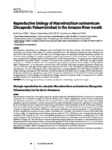Use este identificador para citar ou linkar para este item:
http://www.alice.cnptia.embrapa.br/alice/handle/doc/1031444Registro completo de metadados
| Campo DC | Valor | Idioma |
|---|---|---|
| dc.contributor.author | LIMA, J. de F. | pt_BR |
| dc.contributor.author | CRUZ, M. C. M. da | pt_BR |
| dc.contributor.author | SILVA, L. M. A. da | pt_BR |
| dc.date.accessioned | 2015-12-10T11:11:11Z | pt_BR |
| dc.date.available | 2015-12-10T11:11:11Z | pt_BR |
| dc.date.created | 2015-12-10 | pt_BR |
| dc.date.issued | 2015 | pt_BR |
| dc.identifier.citation | Acta Amazonica, Manaus, v. 45, n. 3, p. 299-306, 2015. | pt_BR |
| dc.identifier.uri | http://www.alice.cnptia.embrapa.br/alice/handle/doc/1031444 | pt_BR |
| dc.description | Macrobrachium surinamicum is an indigenous prawn distributed from the lower Amazon and Tocantins river basins to Venezuela in the Orinoco Delta region. It is common bycatch fauna of Macrobrachium amazonicumartisan fishing in the states of Pará and Amapá. The aim of this study was to investigate aspects on reproductive biology (reproductive period, size of sexual maturity population, fecundity, reproductive output and recruitment) of M. surinamicum from four important areas to artisanal prawn fishing located at the Amazon River mouth (Amapá and Pará). The specimens were captured using 20 handcrafted traps called ?matapi?. A number of 675 prawns were captured, 258 males, 409 females and eight juveniles, resulting in 1:1.6 (Male: Female) sex ratio. The reproductive peak period occurred from March to July, coinciding with the higher rainfall period. The juvenile prawn occurred only in May and July. Total length of egg-bearing females ranged from 12.12 to 38.30 mm, with mean female length at first maturity (L50) of 23.7 mm. Fecundity increased with prawn size and varied between 174 and 1780 eggs per female. Mean egg volume increased gradually from 0.031 (Stage I) to 0.060 mm³ (Stage III) during embryogenesis. Macrobrachium surinamicumdepends on brackish water to complete the larval development. Irrespective of female size, reproductive output of M. surinamicumvaried between 4.3 % and 35.5 % of their body weight for egg production. The knowledge of the reproductive biology reported in the present study is an important tool to define strategies to preserve M. surinamicumin Amazon River mouth. | pt_BR |
| dc.language.iso | eng | eng |
| dc.rights | openAccess | eng |
| dc.subject | Artisanal fisheries | pt_BR |
| dc.title | Reproductive biology of Macrobrachium surinamicum (Decapoda: Palaemonidae) in the Amazon River mouth. | pt_BR |
| dc.type | Artigo de periódico | pt_BR |
| dc.date.updated | 2017-03-14T11:11:11Z | pt_BR |
| dc.subject.thesagro | Reprodução sexuada | pt_BR |
| dc.subject.thesagro | Pesca artesanal | pt_BR |
| dc.subject.nalthesaurus | sexual reproduction | pt_BR |
| riaa.ainfo.id | 1031444 | pt_BR |
| riaa.ainfo.lastupdate | 2017-03-14 | pt_BR |
| dc.identifier.doi | http://dx.doi.org/10.1590/1809-4392201402824 | pt_BR |
| dc.contributor.institution | JO DE FARIAS LIMA, CPAF-AP; Mayara Cristina Moura da Cruz, UEAP; Luis Mauricio Abdon da Silva, IEPA. | pt_BR |
| Aparece nas coleções: | Artigo em periódico indexado (CPAF-AP)  | |
Arquivos associados a este item:
| Arquivo | Descrição | Tamanho | Formato | |
|---|---|---|---|---|
| CPAFAP2015Reproductivebiology.pdf | 707,09 kB | Adobe PDF |  Visualizar/Abrir |









